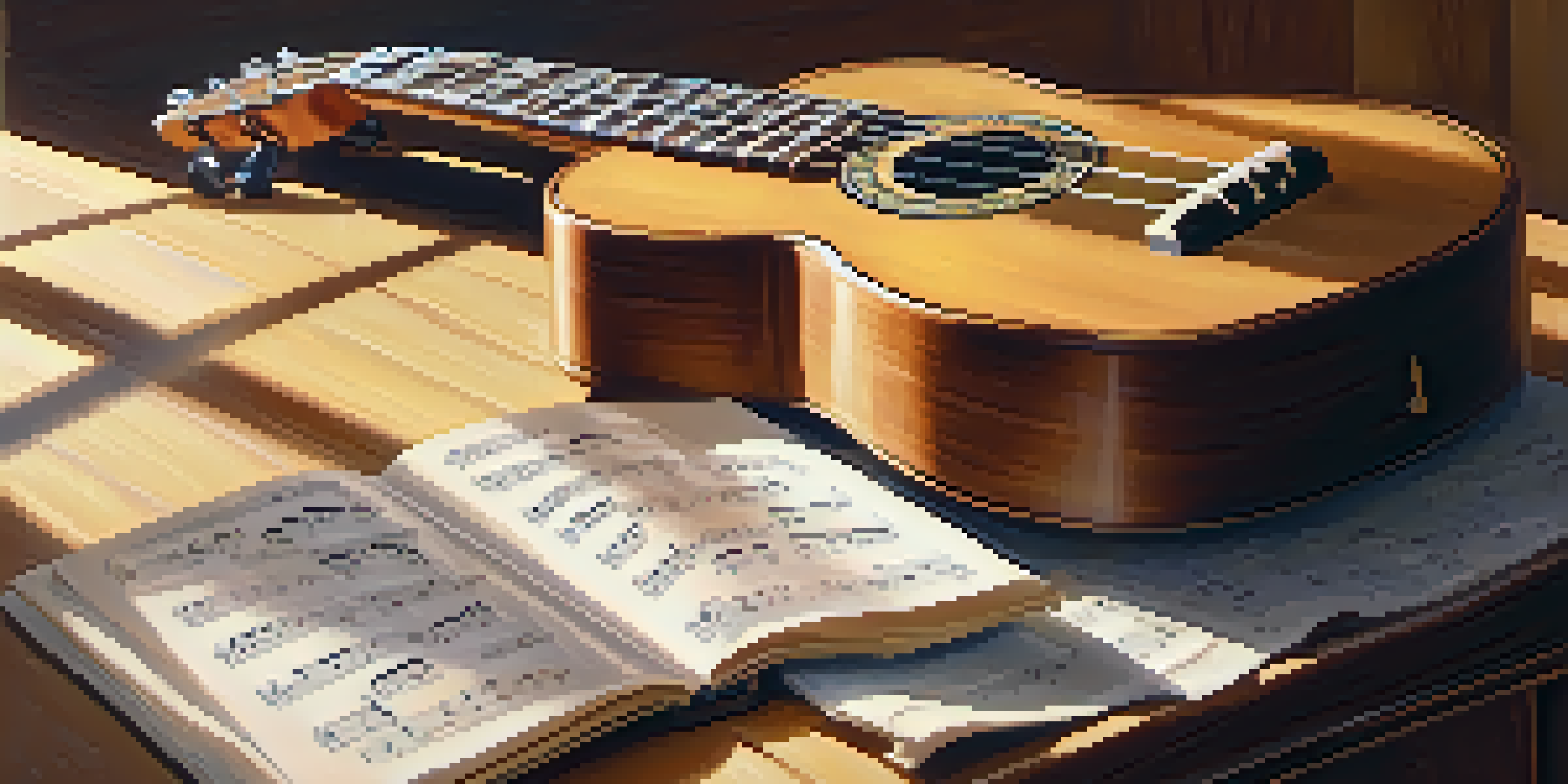Tapping Techniques for Ukulele: A Comprehensive Guide

What is Ukulele Tapping and Why Should You Try It?
Ukulele tapping is a unique technique that allows players to create percussive sounds and melodic lines simultaneously. Imagine playing two instruments at once—this is what tapping can feel like! It’s an exciting way to elevate your ukulele skills and add depth to your playing, making it ideal for both solo performances and jam sessions.
Music is the shorthand of emotion.
By incorporating tapping into your repertoire, you can surprise your audience with intricate rhythms and harmonies that stand out. It’s not just about playing notes; it’s about creating an atmosphere and engaging listeners in a new way. Plus, tapping can help you develop better finger coordination and timing, which are essential skills for any musician.
Whether you're a beginner looking to spice up your playing or an experienced player seeking new challenges, tapping is a technique worth exploring. With practice, you can transform your ukulele into a versatile instrument that can play both melody and rhythm, enriching your overall musical experience.
Getting Started with the Basics of Tapping
Before diving into complex tapping patterns, it's crucial to master the basics. Start by familiarizing yourself with the ukulele fretboard, as knowing where the notes are will make tapping much easier. Begin by practicing simple hammer-ons and pull-offs, which are fundamental techniques that will form the foundation of your tapping skills.

To practice, try playing a basic melody while tapping your fingers on the fretboard to create a rhythm. This can feel a bit awkward at first, but with time, you’ll find your groove. Remember, the key is to keep it simple; focusing on one or two notes will help you build confidence before you tackle more intricate patterns.
Ukulele Tapping Enhances Playing
Incorporating tapping into your ukulele repertoire allows you to create percussive sounds and melodic lines simultaneously, enriching your overall musical experience.
As you gain comfort with these basics, you can gradually introduce more complex tapping techniques. Experiment with different finger placements and rhythms to discover what feels best for you. The more you practice, the more natural tapping will become—a skill that will serve you well in your musical journey.
Essential Finger Techniques for Effective Tapping
Finger positioning is critical when it comes to tapping on the ukulele. The technique often involves using your index and middle fingers to tap the notes while your other fingers hold down chords. Proper finger placement can enhance your accuracy and speed, allowing for cleaner sound production.
The beautiful thing about learning is that no one can take it away from you.
A common approach is to use your dominant hand's fingers to tap on the fretboard while your non-dominant hand focuses on fretting chords. Practicing scales with this technique can help strengthen your fingers and improve coordination. Start slow, ensuring each note rings clearly before increasing your speed.
Additionally, consider using the palm of your hand to mute strings when necessary. This will help prevent unwanted noise, allowing your tapped notes to shine through. As you become more comfortable with these finger techniques, your tapping will become more fluid and expressive, opening up a world of creative possibilities.
Popular Tapping Patterns for Ukulele Players
Once you've grasped the basics, it's time to explore some popular tapping patterns. One effective pattern involves alternating between tapping and plucking strings, creating a dynamic interplay between melody and rhythm. This can be as simple as tapping a note on the 5th fret while strumming an open string.
Another fun pattern is to incorporate arpeggios with tapping. For instance, you can tap the root note of a chord while playing the other notes in the chord sequentially. This adds a beautiful layer of complexity and can really impress your audience during performances.
Master Basics Before Advancing
Familiarizing yourself with basic techniques like hammer-ons and pull-offs is essential before progressing to more complex tapping patterns.
Don't hesitate to mix and match these patterns to develop your unique style. The beauty of tapping lies in its versatility, enabling you to create a sound that is distinctly your own. As you experiment, keep track of the patterns that resonate with you and incorporate them into your playing.
Advanced Tapping Techniques to Challenge Yourself
As you become more confident in your tapping skills, you may want to tackle some advanced techniques. One such technique is legato tapping, where you smoothly connect notes without lifting your fingers off the fretboard. This creates a flowing sound that can be quite captivating when performed correctly.
Another exciting technique is the use of harmonics while tapping. By lightly touching the string at specific points, you can produce bell-like tones that add an ethereal quality to your playing. Combining harmonics with traditional tapping can create a rich tapestry of sound sure to impress any listener.
Finally, consider incorporating syncopation into your tapping patterns. This rhythmic variation adds interest and complexity to your playing, making it more engaging. Don't shy away from experimenting with different styles and genres; the more you challenge yourself, the more you will grow as a musician.
Incorporating Tapping into Your Ukulele Songs
Now that you have a solid understanding of tapping techniques, it’s time to incorporate them into your songs. Start by analyzing your favorite ukulele pieces and identify sections where tapping might enhance the overall sound. This could be during a solo or even as a way to fill in empty spaces between chords.
Try adapting existing songs by adding tapping sections. For example, take a simple chord progression and add a tapping melody on top. This not only makes the song more interesting but also showcases your skills as a musician. Remember, every song is an opportunity to express your creativity.
Explore Unique Tapping Patterns
Experimenting with various tapping patterns and techniques can help you develop your unique style and captivate your audience.
As you write your own music, think about how tapping can play a role in your compositions. Use it to emphasize certain phrases or create transitions between different sections. The more you practice incorporating tapping into your songs, the more natural it will feel, and your unique sound will start to develop.
Resources and Tools for Mastering Ukulele Tapping
To further enhance your tapping skills, consider utilizing various resources available online. Platforms like YouTube offer a wealth of tutorials that can guide you through different techniques and patterns. Watching experienced players can provide valuable insights and inspire your own playing.
Additionally, many ukulele forums and communities exist where you can connect with fellow players. These platforms are fantastic for sharing tips, asking questions, and even collaborating on projects. Engaging with others can provide motivation and a sense of camaraderie on your musical journey.

Finally, don’t forget about the power of practice tools like metronomes and loop pedals. A metronome can help you maintain a steady rhythm while you practice tapping, while a loop pedal allows you to layer your sounds, letting you hear how tapping fits into the larger musical picture. With the right tools and resources, you’ll be well on your way to mastering ukulele tapping.
Conclusion: Embrace the Art of Ukulele Tapping
As you embark on your journey to master ukulele tapping, remember that patience and practice are your best friends. Like any skill, tapping takes time to develop, but the rewards are well worth the effort. Each session of practice brings you closer to achieving your unique sound and style.
Embrace the learning process and don’t be afraid to make mistakes along the way. Each mistake is an opportunity to grow and discover new techniques. Keep experimenting with different tapping patterns, techniques, and songs to find what resonates with you and your audience.
Ultimately, tapping can open up a whole new world of musical expression on the ukulele. So grab your instrument, get those fingers moving, and let the tapping begin! Your musical journey is just getting started, and the possibilities are endless.